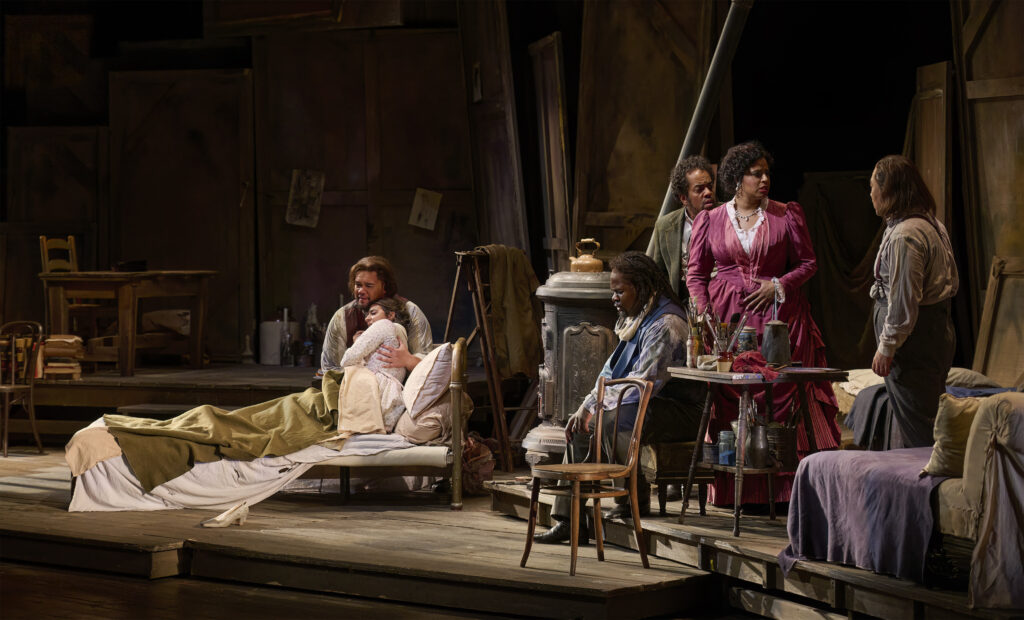In a program note to the Canadian Opera Company’s 2013 iteration of La Bohème, remounted in 2019, currently on repeat offer at Toronto’s Four Seasons Centre, director John Caird considers the notion of Puccinian verismo as determined less by genre, more as the product of informed expression.
Henri Murger, author of Scènes de la vie de bohème, a series of colourful literary sketches, later a play, that would form the basis for Puccini’s libretto, wrote from firsthand knowledge, his characters fictionalized Parisian friends, non-conformists and similarly destitute. Puccini, too, had experienced hard times as a penniless student at the Milan Conservatory in the early 1880s where he shared considerably less than luxurious lodgings with struggling fellow composer Pietro Mascagni. Experience, channeled through the filter of memory, would serve both Murger and Puccini well, resulting, as Caird points out, in a vivid summoning of all that is and was youthful and endearing, then and now.
For this production, designer David Farley and I have chosen to imagine the characters of the opera as our interpreters. If Schaunard, the composer, is represented in the pit by Puccini himself, the scenic world that the bohemians inhabit is as if painted by Marcello.
Rodolfo lingers behind in the bohemians’ miserable ice-cold garret as his friends depart to make the best of Christmas eve at Café Momus. Io resto per terminar l’articolo di fondo del Castoro. (“I’ll stay to finish my article for The Beaver.”) In point of fact, Murger wrote for the same hatmakers’ journal as La Bohème’s idealistic lead from time to time as librettists Giuseppe Giacosa and Luigi Illica well knew.
The force of history, both within and without the opera house, feels as recent as a preceding breath, revival director Katherine M. Carter conjuring all the power of something closely resembling an almost spiritual La Bohème. All the suffering, all the fear unleashed by the pandemic has resulted in a blurring of boundaries between who and when and where. Time has lost absolute authority, Caird’s La Bohème seemingly newer than ever before. Transcendency is very much centre stage.
Paradoxically, for all its seething emotion, La Bohème is bounded, not so much by a coherent overarching story arc, but rather formed from a series of loosely linked vignettes — scenes populated less by grand gestures, more by le piccole cose (“the little things”), as Puccini chose to call them. A lost key. A horn with questionable tone. A salted herring. The Bohemians — Mimi and Rodolfo, Musetta and Marcello, Schaunard and Colline — are framed by the details of their lives. Mimi’s death from consumption, cruel and lingering, will sweep them all away. The present is shattered. Nothing will ever be the same. Except friendship. And the love they bear for one another. Their coming of age, as inevitable as it may be, tears at the heart. Caird’s handling of dramaturgy is deeply affecting.
For all of La Bohème’s outpouring of humanity, however, it is Puccini’s music that confers opera immortality. Premiered at the Teatro Reggio in Turin in 1896, led by then 29-year old maestro, Arturo Toscanini, Bohème has literally moved millions to tears. And continues to do so. Luminous, inexpressibly poignant, haunting, Puccini’s rich, vibrant score effectively leaps over the divide between the epic surge of Italianate passion that is Verdi and the darker, more ominous gesamtkunstwerk of Wagner to create an orchestral masterpiece of sumptuous beauty. Melody is everything here, varied, evocative, intensely heartfelt, occasionally reprised as touching, character-driven motifs. The three great Act I arias that launch La Bohème into the mainstream of our affections — Rodolfo’s Che gelida manina (“What a frozen little hand”), Mimi’s Si. Mi chiamano Mimi (“Yes. They call me Mimi”) and the ravishing duet, O soave fanciulla (“Oh lovely girl”) — float us free of ourselves, centring us in a place of vast compassion.
Leading a lush, brightly tinted Canadian Opera Company Orchestra, conductor Jordan de Souza‚ recently returned from an extended residency with the Komische Oper Berlin, brings a sparkling, youthful vigour to Puccini’s glorious settings.
Amina Edris and Pene Pati appear as doomed lovers, Mimi and Rodolfo. The two are exceptionally well-paired. Generously supported by de Souza and company, the Egyptian-born, New Zealand soprano elicits a profound measure of authenticity, tinting her performance with expressions of stunningly original pianissimo and meticulously considered tempi. Innocence given voice. Pati’s Rodolfo, by way of contrast, is all impetuousness and hyperbole and tumultuous counterpoint. The pair’s treatment of Puccini’s supremely affecting Act III duet, Dunque è proprio finita! (“So, it’s all over!”) soaring and bittersweet, is a moment not soon forgotten.
Mezzo-soprano Charlotte Siegel sings Musetta. Baritone Joo Won Kang sings Marcello. Another rewarding partnership, the two striking dramatic sparks off one another, Siegel strong, harmonically centred, molto assertiva; Joo Won sensitive, broody, vocally explosive.
Fellow baritone Justin Welsh is Schaunard. Bass Blaise Malaba is Colline. Both are excellent. With his relaxed physicality and ringing, high note friendly timbre, Welsh utterly charms, mischievous and high-spirited; Malaba more stylistically and actorly circumspect as per his character, but not without charisma. Colline’s tender ode to his cherished overcoat, Vecchia zimarra, senti (“Dear old coat, listen”), in Malaba’s hands, is moving in the extreme.
Baritone Gregory Dahl does double duty, appearing as both the bohemians’ somewhat witless landlord, Benoit, and Alcindoro, Musetta’s besotted benefactor, payer of shockingly extravagant dinner bills.
The men and women of the Canadian Opera Company Chorus, delightfully amplified by a troop of irresistibly playful singer-actors drawn from the Canadian Children’s Opera Company, boost the bustling Act II street scene to the level of pure enchantment.
Conceived as a concept piece over a decade ago, La Bohème, a joint presentation of San Francisco Opera, Houston Grand Opera and the COC, has proven itself to be far more than merely durable. This thoughtful, radiant mirroring of Puccini’s shining salute to life and loss is quite simply ageless.


